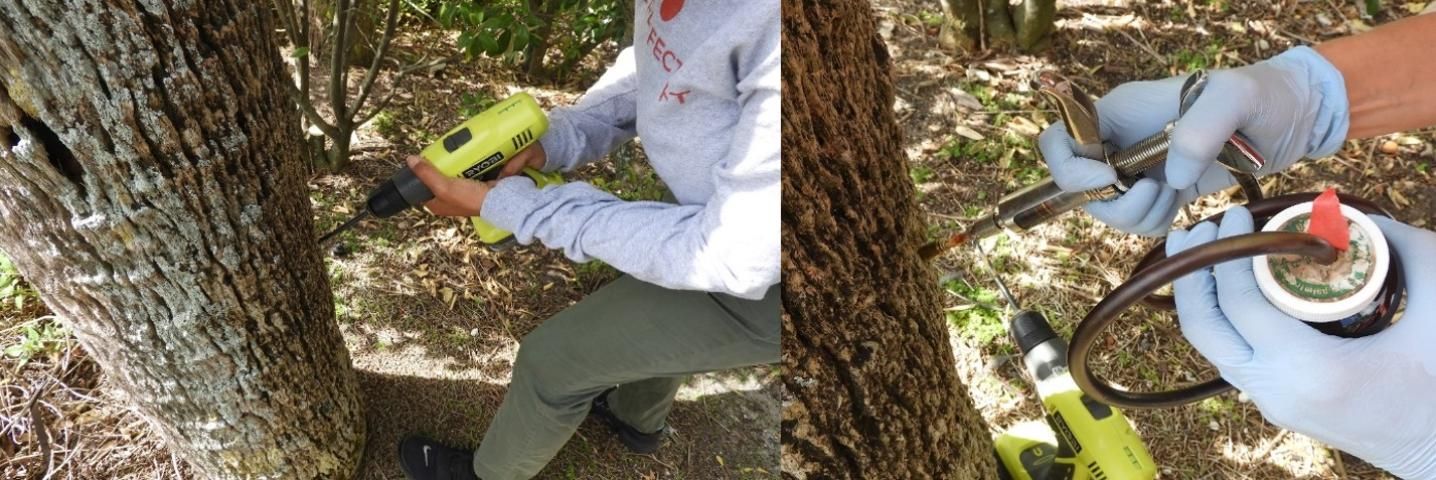Introduction
Phytoplasma diseases of palms are a major threat to the Florida nursery and landscaping industries. Historically, lethal yellowing (LY) has been responsible for the death of millions of coconut palms throughout the Caribbean. LY, introduced into Florida sometime in the first half of the 20th century, has been causing decline of over 30 species of palms (Harrison and Elliott 2015). In 2006, lethal bronzing disease (LBD) (formerly called Texas Phoenix palm decline or TPPD) was discovered on the west coast of Florida near Tampa. This phytoplasma disease has since been associated with decline of 11 different species of palms throughout the state of Florida. Management of phytoplasmas in palms relies on tree removal and injection with the antibiotic oxytetracycline hydrochloride (OTC-HCl).
Oxytetracycline hydrochloride (OTC-HCl)
Phytoplasmas are a type of bacteria that have lost the cell wall over evolutionary time. The closest living relatives to phytoplasmas are bacteria that belong to the genus Bacillus, which are gram-positive bacteria (i.e., they possess a cell wall) (Figure 1). Oxytetracycline hydrochloride (OTC-HCl) is an antibiotic (Figure 2) that is used to treat for infections caused by both gram-positive and gram-negative bacteria (i.e., bacteria that lack a cell wall) (Figure 1). The mode of action for OTC-HCl is by preventing protein synthesis that ultimately results in cell death. The properly formulated OTC-HCl for use in palms can be purchased from Tree Saver® (http://www.palmtreesaver.com/) along with the equipment necessary to inject (Figure 3), with the exception of a power drill and hand-held torch. These items can be purchased at any home-improvement or hardware store.



Injection of OTC-HCl
The recommended way to treat palms with OTC-HCl is to inject five milliliters (5 ml at) approximately 956 ppm of the solution into the base of the trunk every three months (quarterly). The first step is to prepare the antibiotic solution by mixing OTC-HCl powder with distilled water. If injecting fewer than 30 trees, mix individual doses. One teaspoon (2.9 g) of OTC mixed with three milliliters (3 ml) of distilled water makes a dose for one palm. A full bottle of OTC-HCl (86 g) will treat about 30 palms, and if at least 30 palms will be treated, 90 milliliters (90 ml) of distilled water can be added directly to the bottle. Regardless of the amount prepared, stir the solution until all powder dissolves. Fill a syringe by inserting the tip into the OTC-HCl solution and drawing back the plunger, or if the syringe is attached directly to the jar, prime it by retracting the pump handle until the glass cartridge is full. Once the syringe with OTC-HCl solution is ready, choose a location on the trunk for injecting. Using a 5/16-inch drill bit that is six to eight inches long, drill a hole into the trunk at a slightly downward angle (Figure 4) to a depth about equal to the drill bit (i.e., drill the hole until the drill chuck touches the trunk, about 6 to 8 inches deep. Next, insert the injection valve into the hole narrow end first, and gently tap it in flush with a hammer. Insert the syringe needle into the valve to the base of the needle and inject the OTC solution into the palm (Figure 4). Once all five milliliters of OTC have been injected, remove the syringe. If more than one tree will be injected, flame sterilize the drill bit and cool it before drilling the injection site in the next tree.

Current Research Efforts
All recommendations for OTC treatments were developed for treatments against lethal yellowing (LY). To date, no research has been conducted to evaluate the effectiveness of OTC against LBD, and the recommended rates are based on the assumption that LBD will respond the same way as LY to OTC injections. While it is possible that OTC is equally as effective against LBD, this is not guaranteed. Ongoing research will evaluate the effectiveness of OTC against LBD. Injection of OTC has also been recommended as a preventative measure. It appears most effective when injected into healthy palms to prevent new infections. Once symptoms develop, results appear mixed.
Working Protocol
- Calculate amount of OTC-HCl to mix into solution..........................................
- Mix solution, either in the bottle supplied or in a small tray...............................
- Load OTC-HCl solution into injector...........................................................
- Drill hole into tree with 5/16-inch drill bit at a downward angle.........................
- Flame sterilize drill bit..............................................................................
- Insert valve into hole and gently tap in with hammer.......................................
- Insert syringe into valve and inject OTC.......................................................
- Withdraw syringe and re-load injector if injecting additional palms.......................
- Repeat steps 3 to 8 for each additional palm...................................................
- Flame sterilize drill, clean equipment and store accordingly................................